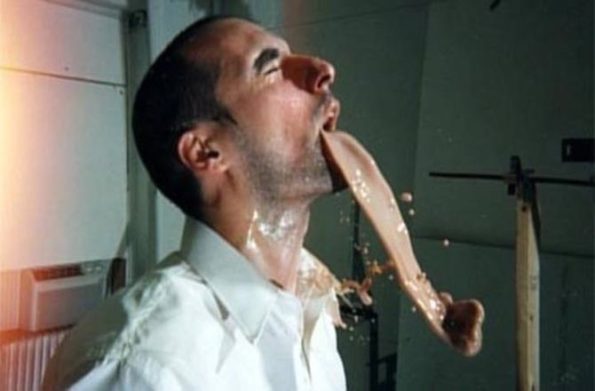Search
To search for an exact match, type the word or phrase you want in quotation marks.
A*DESK has been offering since 2002 contents about criticism and contemporary art. A*DESK has become consolidated thanks to all those who have believed in the project, all those who have followed us, debating, participating and collaborating. Many people have collaborated with A*DESK, and continue to do so. Their efforts, knowledge and belief in the project are what make it grow internationally. At A*DESK we have also generated work for over one hundred professionals in culture, from small collaborations with reviews and classes, to more prolonged and intense collaborations.
At A*DESK we believe in the need for free and universal access to culture and knowledge. We want to carry on being independent, remaining open to more ideas and opinions. If you believe in A*DESK, we need your backing to be able to continue. You can now participate in the project by supporting it. You can choose how much you want to contribute to the project.
You can decide how much you want to bring to the project.

The German term “Treppenwitz”, describes the act of thinking of a retort to a question just that bit too late that usually occurs in unexpected places. I went to Madrid with the question, how can we articulate mediation (as agents, artists, educators, curators) in our projects? I went to the CaixaForum in Madrid where “Les maîtres du désordre” was being exhibited, curated by Jean de Loisy, president of the Palais de Tokyo in Paris. Articulated in three large sections “The imperfect order”, “The power of disorder” and “The catharsis”, the exhibition analyses the notion of disorder through different modes of negotiating with entities of power. Negotiation, dialogue, mediation, that gives way to subversion, obscenity, the bacchanal, the fiesta, and finally the new order. The question of mediation continued in time, shifting from the exhibition to the events that followed.
In the space, pieces from ethnographic, anthropological and private collections, such as; masks, costumes, amulets, batons and other shamanic panoply, sit alongside contemporary pieces of diverse formats by Thomas Hirschhorn; Joseph Beuys, explaining paintings to a dead hare; Anna Halprin with “Dancing my cancer”; Paul McCarthy with “Painter”; Oleg Kulik restrained like a “mad dog”; Anette Messaguer; Esther Ferrer; Antoni Tàpies; Sergio Prego; Jacques Lizènne; Stephen Dean; Jonathan Messe, amongst others, as well as other interviews, videos and documentary material.
Artist-mediators, in their practice, record like ethnographers, activating as a sensor for the production of knowledge and generating “meaning” about their surroundings. The performative nature of the narratives there seemed to be a disruptive gesture in itself, after a long exhausting period, the need for change or a lack of understanding of the power that it is dialoguing with. The eerie ambiance and my sensation on leaving, was like that of coming across an explosion and falling directly into the depths. “Disorder”, through dissimilar pathways of negotiation, leads us to chaos, from there to catharsis and from there, to the new order. The question of chaos and order, beyond the rituals and shamans, is also a political question. It can annihilate, but it can also save. Everything sounded like a warning, about the terrain of the known and the unknown –the new paradigm of social order into which we are headed–, the visible –the obscene aspect of the exhibition, the control over all of us– and the invisible –the powers of the collective -. The reading was an invitation to break ranks.
Back in Barcelona, through a discussion group, the structure of “Les maîtres du désordre” shifted from one moment to another. The first conversation, inserted into ‘L’ordre Imparfait’, bringing forward the impossibility of doing and saying that lead on to literality, narrativity, the dilution of the discourse and finally, to the body and its ultimate physicality. Later Dora García passed through ‘El Dominio Del Desorden’ confronting, ethical conventions through art, placing herself against the “excellence” of thought. Leaving ethics and morality hanging in the balance. Then Valentín Roma left us the ‘Palabras de Iniciados’, roaming through Tàpies Contra Tàpies, in an act that is in turn complex and not complex, a reading of Tàpies and the art that ended up in dimensions closer to the body. Converting mediation into a state of the question and not the question in itself. And finally Oscar Abril indicated the road to ‘Catharsis’ making it clear that the paradigm of modern society will only modify, when DIY becomes DIWO (Do it with others).
Factors in common: the performativity of the discourses, the events, the displacement of the gaze, and the questioning of truth. They all talk about the moment when the mediator aims to revert that of “being quiet, seated, listening and concentrating, to later applaud and leave”. It’s no coincidence.
Mediation passes through the arena of the collective when it is a process that is continually emitted and prone to adaptation. Already it is a matter within the collective domain. It is therefore articulated through a body with a voice, in the name of its discipline and others. The mediators each time reconfiguring according to their strategy. The mediation finally becomes a dynamic and performative process, acquiring in its role a political dimension, in relation to the rest.
I imagine that maybe a state of crisis, like the one we are currently experiencing, will be followed by a moment of catharsis or various, that will resituate a totally new paradigm. Until this happens it’s worth asking: where, how and through whom, or with what, will the catharsis of this crisis occur? Will it happen through social radicalism? Is the art world well placed as a political subject to be able to give an effective response to this new paradigm? What is the role of the mediators here?
If culture is the most revolutionary option in the long term, as Montse Badia pointed out not so long ago, we each need from our own position, to mediate, in order to reformat the surfaces where the values that no longer serve us have been imposed and recuperate the essential: in the first instance the body.
Without leaving the stairway I think: the “Treppenwitz” moment seems to happen a bit like mediation; in the stairway, after “such and such”, or in the company “of”, endeavouring to recreate the situation so as to be able to in the end come up with a retort.

I landed in Barcelona and then in this world. Passing from 31º to 10º was I think the worst of it, but that’s water under the bridge. In tune with the current general precariousness, I don’t need a boss, I already have one inbuilt. For a long time I was silent and then one day I decided to talk, to write. I’m fascinated with the investigation of processes, things, experiences and their social and political dimensions. I’m convinced that art is a form of knowledge, that I hope helps us to understand much of what escapes us.
"A desk is a dangerous place from which to watch the world" (John Le Carré)